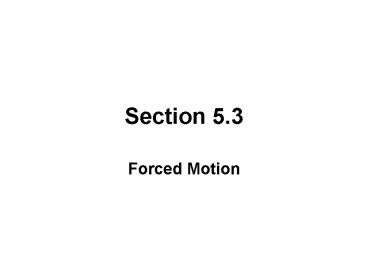Forced Motion - PowerPoint PPT Presentation
Title:
Forced Motion
Description:
Section 5.3 Forced Motion FORCED MOTION SOLVING A FORCED MOTION DE TRANSIENT SOLUTION AND STEADY-STATE SOLUTION Section 5.3 Forced Motion FORCED MOTION SOLVING A ... – PowerPoint PPT presentation
Number of Views:22
Avg rating:3.0/5.0
Title: Forced Motion
1
Section 5.3
- Forced Motion
2
FORCED MOTION
Suppose we take into account an external force f
(t) acting on a vibrating mass on a spring.
Including f (t) in the formulation of Newtons
second law gives the differential equation of
forced motion.
where F(t) f (t)/m, 2? ß/m, and ?2 k/m.
3
SOLVING A FORCEDMOTION DE
There is no general solution for the DE on the
previous slide. It is a nonhomogeneous DE and
will have a complimentary solution xc(t) and a
particular solution xp(t). The particular
solution depends upon the function F(x). The
complementary solution will be the solution to
- simple harmonic motion (Section 5.1) if the
system is undamped, and - damped motion (Section 5.2) if the system is
damped.
4
TRANSIENT SOLUTION AND STEADY-STATE SOLUTION
If xc(t) ? 0 as t ? 8, it is said to be a
transient term, or transient solution. So, for
large values of t, the displacement of the weight
is closely approximated by the particular
solution xp(t). The particular solution is also
called the steady-state solution. Transient and
steady-state solutions only occur with damped
motion.































